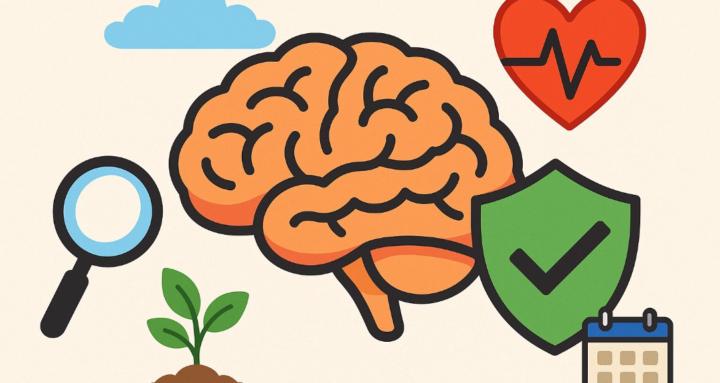Stroke Proof - Stress check in
Chronic stress is a major cause of stroke and is one of the 10 factors identified by the INTERSTROKE study that cause 90% of strokes. However, most people have no way to catch rising stress. We usually spot it when it's too late. So today's tip: Once a day ask yourself: “Am I reacting more than I’m responding?” If yes → use 30 seconds of slow breathing or a short walk. It’s a simple cue that interrupts stress-driven cortisol surges. Then use the headspace you've bought to do something constructive that will meaningfully reduce your stress going forward. Tackle the underlying cause of your stress.
Pause on the prevention tips
Hi everyone. I count that we've done 43 stroke prevention tips, pretty much every order day. We're going to pause the tips temporarily for a few weeks until the new year. Partly to free up time for Christmas and partly because I'm struggling to come up with more ideas! However, I will use that time to write some more stuff in the classroom section. We'll also still have our prevention catch up (next one on Sunday) and I hope we'll keep up our chats in the group too.
🚭 Stroke-Proof Tip: Quit Smoking — Your Brain Will Thank You
I hope none of us smoke, but if you do this one's is for you. If there’s one lifestyle change that delivers immediate and lifelong protection against stroke, it’s stopping smoking. Smoking is one of the top 10 modifiable factors that explain over 90% of all strokes worldwide. Nicotine and tobacco smoke damage blood vessels, accelerate plaque build-up, thicken your blood, and increase your risk of clots — the perfect storm for a stroke. The Good News? The benefits start within minutes. 20 minutes: Blood pressure and heart rate begin to normalise 2–12 weeks: Circulation and lung function improve 1 year: Stroke risk drops by around 50% 5 years: Stroke risk approaches that of a lifelong non-smoker Why this matters for you Every cigarette increases stroke risk, but stopping shifts the trajectory rapidly. No other intervention reduces risk quite as quickly or as powerfully across the brain, heart, and vascular system. If you're trying to quit You don’t have to do it alone. Nicotine replacement, prescription supports, and structured coaching all significantly increase success rates — and the payoff is enormous. You can get this for free anywhere in the UK. Just Google stop smoking and your nearest town or city. Your brain deserves better. Your future self will be grateful you made this choice today.
🌼 Mindful Sunday: Pause, Breathe, Reset
Feeling overwhelmed? Life moves quickly, and stress often sneaks in without warning. When it does, pause, take a deep breath, and try this simple technique to bring your mind back to the present and protect your health. The 5-4-3-2-1 Method 👀 5 things you can see Take a slow look around. Notice colors, shapes, patterns, light. ✋ 4 things you can touch Feel the texture of your clothes, a chair, a blanket, or the floor beneath your feet. 👂 3 things you can hear Tune in to birds, distant traffic, soft hums, or your own breathing. 👃 2 things you can smell Breathe in the scents around you: coffee, fresh air, a candle, or something nearby. 👅 1 thing you can taste Sip water, or simply notice the natural taste in your mouth. ✅ Why It Works • Interrupts racing thoughts • Encourages slower, deeper breathing • Calms the body’s stress response • Easy to do anywhere, anytime in under a minute. 🌿 Managing stress lowers blood pressure, reduces inflammation, and supports healthier daily habits, all essential for reducing stroke risk. ✨ Take a moment today to ground yourself. A one-minute reset can shift the tone of your entire day.
0
0
Walnuts, Chia & Salmon - Your Brain’s Dream Team 🧠💚
These delicious foods have one thing in common: they’re packed with omega-3 fats, essential nutrients your body can’t make on its own - your heart, brain, and blood vessels depend on them. 🔬 Meet the Omega-3 Trio - ALA (alpha-linolenic acid): Found in plant foods. Your body can convert ALA into EPA and DHA, but only in small amounts. - EPA (eisosapentaneoic acid) & DHA (docosahexaenoic acid): Found mainly in oily fish. These are the most potent forms for protecting your heart, brain, and circulation. How Omega-3s Help Prevent Stroke? EPA and DHA support your cardiovascular system and brain health through multiple powerful mechanisms: 🛡️ Reduce inflammation - keeping blood vessels resilient 🛡️ Lower triglycerides - reducing artery narrowing 🛡️ Improve endothelial function - smoother, more elastic vessels 🛡️ Reduce arterial stiffness - easing strain on brain circulation 🛡️ Act as natural antiplatelets - lowering clot risk 🛡️ Lower blood pressure - a major stroke risk 🛡️ Reduce resting heart rate - supporting overall cardiovascular stability 📊 Science Spotlight Large-scale research shows that higher blood levels of omega-3 fats (especially EPA and DHA) are linked to a lower risk of ischemic stroke https://www.ahajournals.org/doi/10.1161/STROKEAHA.123.044281 ⭐ Best Food Sources of Omega-3 🐟 Top EPA & DHA Sources: Salmon, Mackerel, Herring, Sardines, Anchovies, Pilchards, Trout 🌱 Best ALA Plant Sources: Walnuts, Chia seeds, Flaxseed/linseed, Flaxseed oil, Hemp seeds, Pumpkin seeds, Rapeseed oil, Spinach, kale & leafy greens 💡 How to Get More Omega-3s Into Your Week 🍣 Eat 2 portions of fish/week (at least 1 oily) 🌰 Add walnuts to breakfast or salads 🌿 Sprinkle chia or flax into porridge or yoghurt 🫒 Cook with oils like flaxseed, walnut, or rapeseed 🥗 Include leafy greens like spinach and kale
1-30 of 45
powered by

skool.com/stroke-proof-3705
We use real evidence — not hype — to take every step possible to prevent strokes and live longer, healthier, happier lives.
Suggested communities
Powered by


